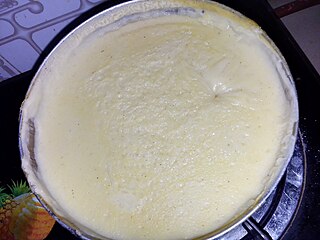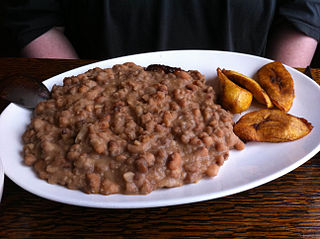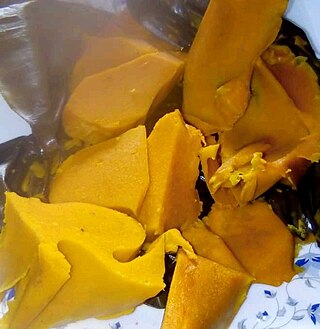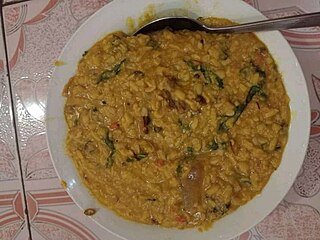Related Research Articles

Porridge is a food made by heating or boiling ground, crushed or chopped starchy plants, typically grain, in milk or water. It is often cooked or served with added flavourings such as sugar, honey, fruit, or syrup to make a sweet cereal, or it can be mixed with spices, meat, or vegetables to make a savoury dish. It is usually served hot in a bowl, depending on its consistency. Oat porridge, or oatmeal, is one of the most common types of porridge. Gruel is a thinner version of porridge and congee is a savoury variation of porridge of Asian origin.

Cornmeal is a meal ground from dried corn (maize). It is a common staple food and is ground to coarse, medium, and fine consistencies, but it is not as fine as wheat flour can be. In Mexico, very finely ground cornmeal is referred to as corn flour. When fine cornmeal is made from maize that has been soaked in an alkaline solution, e.g., limewater, it is called masa harina, which is used for making arepas, tamales, and tortillas. Boiled cornmeal is called polenta in Italy and is also a traditional dish and bread substitute in Romania.

Champurrado is a chocolate-based atole, a warm and thick Mexican beverage. It is prepared with either a masa , masa harina, or corn flour ; piloncillo; water or milk; and occasionally containing cinnamon, anise seed, or vanilla. Ground nuts, orange zest, and egg can also be added to thicken and enrich the drink. Atole drinks are whipped up using a wooden whisk called a molinillo. The whisk is rolled between the palms of the hands, then moved back and forth in the mixture, until it is aerated and frothy; a blender may also be used.

Ugali, also known as posho, nsima, and other names, is a type of corn meal made from maize or corn flour in several countries in Africa. It is cooked in boiling water or milk until it reaches a stiff or firm dough-like consistency. In 2017, the dish was added to the UNESCO Representative List of the Intangible Cultural Heritage of Humanity, one of a few foods in the list.

Moin-moin ( Yoruba) or moi-moi is a steamed or boiled bean pudding made from a mixture of washed and peeled beans and onions, fresh red peppers, spices, and often fish, eggs, and/or crayfish. It is a protein-rich Yoruba food that is commonly eaten across West Africa.

Ghanaian cuisines refer to the meals of the Ghanaian people. The main dishes of Ghana are organized around starchy staple foods, accompanied by either sauce or soup as well as a source of protein. The main ingredients for the vast majority of soups and stews are tomatoes, hot peppers, and onions. Most Ghanaian soups and stews are red or orange in appearance as a result of the main ingredients used.

Àkàrà (Yoruba) (English: bean cake; Hausa: kosai; Portuguese: acarajé is a type of fritter made from cowpeas or beans in Nigeria, Togo and Benin. It is found throughout West African, Caribbean, and Brazilian cuisines. The dish is traditionally encountered in Brazil's northeastern state of Bahia, especially in the city of Salvador. Acarajé serves as both a religious offering to the gods in the Candomblé religion and as street food. The dish was brought by enslaved peoples from West Africa, and can still be found in various forms in Nigeria, Ghana, Togo, Benin, Mali, Gambia, Burkina Faso and Sierra Leone.

Ogi is a fermented cereal pudding and popular street food from Nigeria, typically made from maize, sorghum, guinea corn or millet. Traditionally, the grains are soaked in water for up to three days, before wet-milling or grounding and sieving to remove husks. The filtered cereal is then allowed to ferment for up to three days until sour. It is then boiled into a pap, or cooked to make a creamy pudding also known as Agidi or Eko. It may be eaten with moin moin, akara/acarajé or bread depending on individual choice.

Nigerian cuisine consists of dishes or food items from the hundreds of Native African ethnic groups that comprise Nigeria. Like other West African cuisines, it uses spices and herbs with palm or groundnut oil to create deeply flavored sauces and soups.

The cuisine of Eswatini is largely determined by the seasons and the geographical region. Staple foods in Eswatini include sorghum and maize, often served with goat meat, a very popular livestock there. The farming industry mainly depends on sugar cane, tobacco, rice, corn, peanuts, and the exportation of goat meat and beef. Many Swazis are subsistence farmers who supplement their diet with food bought from markets.

Basotho cuisine features African traditions and British influence. Lesotho is surrounded by South Africa and it shares culinary practices with its neighbor.

Ofada rice is a Yoruba dish. It is the name of an indigenous rice from a small community called Ofada, located in the Obafemi Owode Local Government Area of Ogun State. It is not exclusively grown in the community, but it is an indigenous rice grown in southwest Nigeria but named after the Ofada community. It is used in making a variety of dishes. Ofada rice are mostly blends, and some of the rice varieties in the blends are not indigenous to Africa; however, they usually also contain African rice. It is grown almost exclusively in Ogun State, a state in southwestern Nigeria. Ofada rice is grown on free-draining soil where the water table is permanently below the root of the plant.

Ewa aganyin (Yoruba) (also spelled as Ewa agoyin) is a Yoruba dish commonly eaten in Nigeria. It is also popular as street food. The dish consists of beans cooked until extremely soft and then mashed. Other ingredients, such as bell peppers, onion, ginger, dried chilies and palm oil, are added to form a stew. It is commonly eaten with bread, a popular combination in Africa.

Koko is a spicy millet porridge. It is a popular Nigerian and Ghanaian street food and commonly consumed as a breakfast meal. It can also be taken in late afternoon as snack. Koko is made from many grains including millet with a few local spices added to give it a particular taste and color. It is called Hausa koko in areas where it was introduced by Hausa-speaking people. In northern Ghana, the term 'Hausa koko' is not used. Instead, porridge made from millet is called 'za koko' in Dagbanli. Several types of porridge are made from corn, millet, and sorghum. Other types of porridge include koko talli/salli, zimbuli, among others. It is also common in the various communities in both countries.
Hausa cuisines are traditional and modern food prepared by Hausa people. It is based on the availability of raw food materials they can farm or provide from other places. Most times Hausa people depend purely on the farm products they have cultivated for food preparations. Hausa people have a meal that is common to most Zongo communities called Tuo Zaafi.

Koose also known as Bean Cake is a spicy black-eyed pea fritter that is commonly eaten in West Africa as a snack. It is often taken with porridge. Sometimes it is sandwiched in bread, and called "Koose Bread" or "Paanu Kooshe".

Okpa is a dish prepared by the Igbo people with a type of beans known as Bambara nuts. It is common in Enugu state and classified as a traditional Nigerian delicacy. It is not exclusively eaten by the Igbo, nor is it universal among the Igbo ; other ethnic groups often eat it, and it may be that this is most-common in Niger State. Other Igbo names for okpa include ịgba and ntucha. In Hausa, it is known as gurjiya or kwaruru.

Ukwa is a Nigerian dish eaten by the Igbo people of the south-Eastern region. It can be eaten fresh or prepared as a porridge.
Aadun is a street snack popular among the Yoruba speaking states in Nigeria. The name aadun means sweetness and it is also commonly served at weddings and naming ceremonies.

Egbo is a Yoruba dish popular especially among the people from Ibadan. The food is made from dry corn which is cooked until soft.
References
- ↑ "How To Make Adalu (Beans And Corn)". The Guardian Nigeria News - Nigeria and World News. 2020-02-09. Retrieved 2022-06-25.
- ↑ Onyeakagbu, Adaobi (2020-07-01). "How to prepare beans and corn porridge". Pulse Nigeria. Retrieved 2022-06-25.
- ↑ "Adalu: Beans and corn porridge". Tribune Online. 2018-07-07. Retrieved 2022-06-25.